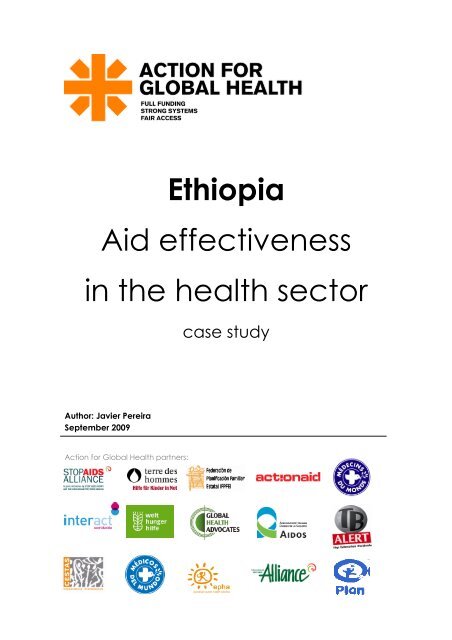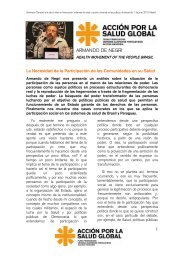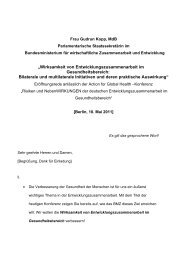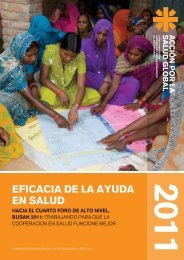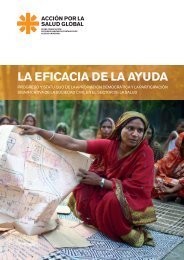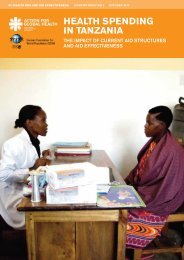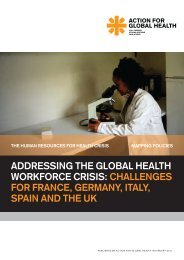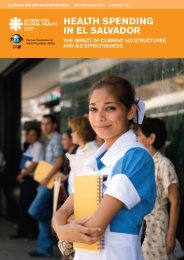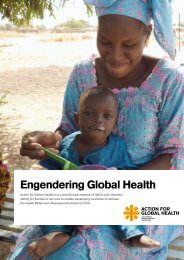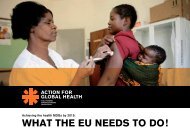Ethiopia Aid effectiveness in the health sector - Action for Global ...
Ethiopia Aid effectiveness in the health sector - Action for Global ...
Ethiopia Aid effectiveness in the health sector - Action for Global ...
Create successful ePaper yourself
Turn your PDF publications into a flip-book with our unique Google optimized e-Paper software.
<strong>Ethiopia</strong><br />
<strong>Aid</strong> <strong>effectiveness</strong><br />
<strong>in</strong> <strong>the</strong> <strong>health</strong> <strong>sector</strong><br />
Author: Javier Pereira<br />
September 2009<br />
<strong>Action</strong> <strong>for</strong> <strong>Global</strong> Health partners:<br />
case study
<strong>Ethiopia</strong> – <strong>Aid</strong> Effectiveness <strong>in</strong> <strong>the</strong> <strong>health</strong> <strong>sector</strong><br />
Table of contents<br />
Acronyms......................................................................................................................... 3<br />
Methodology .................................................................................................................. 4<br />
Executive summary........................................................................................................ 6<br />
1. Country overview....................................................................................................... 8<br />
Progress <strong>in</strong> <strong>the</strong> <strong>health</strong> <strong>sector</strong>..................................................................................... 8<br />
<strong>Aid</strong> programmes <strong>in</strong> <strong>the</strong> <strong>health</strong> <strong>sector</strong>...................................................................... 9<br />
2. <strong>Aid</strong> Effectiveness <strong>in</strong> <strong>Ethiopia</strong>................................................................................... 11<br />
Alignment, harmonisation and budget support .................................................. 11<br />
Vertical donors, a w<strong>in</strong>d shift?.................................................................................. 13<br />
Country ownership ................................................................................................... 15<br />
IHP+............................................................................................................................. 16<br />
Politics are part of <strong>the</strong> aid game ........................................................................... 18<br />
3. Democratic ownership............................................................................................ 19<br />
Overview of CSOs <strong>in</strong> <strong>Ethiopia</strong> ................................................................................. 19<br />
CSO regulation ......................................................................................................... 20<br />
The role of CSOs <strong>in</strong> <strong>the</strong> <strong>health</strong> <strong>sector</strong>..................................................................... 22<br />
4. Conclusions and recommendations..................................................................... 23<br />
Endnotes........................................................................................................................ 25<br />
2
<strong>Ethiopia</strong> – <strong>Aid</strong> Effectiveness <strong>in</strong> <strong>the</strong> <strong>health</strong> <strong>sector</strong><br />
Acronyms<br />
AAA – Accra Agenda <strong>for</strong> <strong>Action</strong><br />
AE - <strong>Aid</strong> Effectiveness<br />
CCM - Country Coord<strong>in</strong>ation Mechanism<br />
CSO - Civil Society Organisation<br />
DAG - Development Assistance Group<br />
DANIDA - Danish International Development Agency<br />
DFID - UK Department <strong>for</strong> International Development<br />
DoL - Division of Labour<br />
DP - Development Partner<br />
EC - European Commission<br />
EIFDDA - <strong>Ethiopia</strong>n Inter-Faith Forum <strong>for</strong> Development, Dialogue and <strong>Action</strong><br />
EPRDF - <strong>Ethiopia</strong>n People's Revolutionary Democratic Front<br />
GDP - Gross Domestic Product<br />
HDI - Human Development Index<br />
HSDP - Health Sector Development Plan<br />
HEP - Health Extension Program<br />
HEW - Health Extension Worker<br />
IMF - International Monetary Fund<br />
INGO - International Non-Governmental Organisation<br />
MDG - Millennium Development Goal<br />
MoU - Memorandum of Understand<strong>in</strong>g<br />
NEP+ - Networks of HIV Positives <strong>in</strong> <strong>Ethiopia</strong><br />
NGO - Non-Governmental Organisation<br />
NSA - Non-State Actor<br />
ODA - Official Development Assistance<br />
OECD - Organisation <strong>for</strong> Economic Cooperation and Development<br />
OECD-DAC - OECD Development Assistance Committee<br />
PAF - Per<strong>for</strong>mance Assessment Framework<br />
PBS - Protection of Basic Services<br />
PD - Paris Declaration<br />
PEPFAR - US President's Emergency Plan <strong>for</strong> AIDS Relief<br />
SAG - Sector Advisory Group<br />
SWG - Sectoral Work<strong>in</strong>g Group<br />
SWAp – Sector-Wide Approaches<br />
TB – Tuberculosis<br />
TWG- Technical Work<strong>in</strong>g Group<br />
3
<strong>Ethiopia</strong> – <strong>Aid</strong> Effectiveness <strong>in</strong> <strong>the</strong> <strong>health</strong> <strong>sector</strong><br />
UN - United Nations<br />
UNICEF – United Nations Children’s Fund<br />
UNDP – United Nations Development Fund<br />
USAID - United States Agency <strong>for</strong> International Development<br />
USG – US Government<br />
VCHW- Volunteer Community Health Worker<br />
WHO – World Health Organisation<br />
Methodology<br />
This report is based on orig<strong>in</strong>al research carried out between July and<br />
September 2009 us<strong>in</strong>g qualitative methods. The process was divided <strong>in</strong>to five<br />
different and consecutive stages.<br />
1. Preparatory research<br />
A literature review of all exist<strong>in</strong>g material such as publications, policy, and case<br />
study research and methodologies helped to shape <strong>the</strong> research design. After<br />
identify<strong>in</strong>g <strong>the</strong> different sources of <strong>in</strong><strong>for</strong>mation, a list of key <strong>in</strong><strong>for</strong>mants from<br />
different backgrounds was elaborated.<br />
2. Contact and network<strong>in</strong>g<br />
Be<strong>for</strong>e <strong>the</strong> <strong>in</strong>terviews, all possible contributors to <strong>the</strong> research were contacted;<br />
<strong>the</strong> purpose and scope of <strong>the</strong> research was expla<strong>in</strong>ed (a summary of <strong>the</strong><br />
research plan was sent to all <strong>the</strong> <strong>in</strong><strong>for</strong>mants), and several letters and faxes were<br />
sent out, ask<strong>in</strong>g <strong>for</strong> permission to carry out <strong>the</strong> <strong>in</strong>terviews.<br />
3. Research trip and <strong>in</strong>terviews<br />
At <strong>the</strong> end of July and beg<strong>in</strong>n<strong>in</strong>g of August 2009, <strong>in</strong>terviews were carried out <strong>in</strong><br />
Addis Ababa. Notes were taken by hand dur<strong>in</strong>g <strong>the</strong> <strong>in</strong>terview and afterwards.<br />
Thus quotes are sometimes approximations. Some <strong>in</strong>terviewees were <strong>the</strong>n<br />
contacted aga<strong>in</strong> by email <strong>in</strong> order to clarify certa<strong>in</strong> aspects of <strong>the</strong>ir<br />
contributions.<br />
4. Review of <strong>in</strong><strong>for</strong>mation and elaboration of a first draft<br />
After ga<strong>the</strong>r<strong>in</strong>g all <strong>the</strong> <strong>in</strong><strong>for</strong>mation, a first draft was elaborated and sent to<br />
<strong>Action</strong> <strong>for</strong> <strong>Global</strong> Health at <strong>the</strong> end of August 2009. The report was<br />
subsequently adapted accord<strong>in</strong>g to <strong>the</strong> suggestions and comments received.<br />
5. F<strong>in</strong>al version<br />
The f<strong>in</strong>al version of this report was submitted on <strong>the</strong> 15 September 2009.<br />
List of <strong>in</strong>terviewees:<br />
• Hailom Bante, IHP+ National Expert<br />
• Iyasu Dagmawi, P.H.C & D Technical Support Service (development<br />
consultancy)<br />
• Kunal Dhar, Governance Adviser, DAG <strong>Ethiopia</strong> – Governance TWG<br />
4
<strong>Ethiopia</strong> – <strong>Aid</strong> Effectiveness <strong>in</strong> <strong>the</strong> <strong>health</strong> <strong>sector</strong><br />
• Holie Folie, Director, Consortium of Reproductive Health Associations<br />
(CORHA)<br />
• Richard Gregory, Deputy Health Adviser, DFID <strong>Ethiopia</strong><br />
• Alexander O’Riordan, <strong>Aid</strong> Effectiveness Expert, Delegation of <strong>the</strong> EC<br />
• Dr. Theo Pas, Sector Specialist Health, HIV/AIDS, Royal Ne<strong>the</strong>rlands<br />
Embassy<br />
• Dr. Meshesha Shewarega, Director, Christian Relief & Development<br />
Association (CRDA)<br />
• Marisa Traniello, Programme Manager, Procurement and Supply Cha<strong>in</strong><br />
Management, Cl<strong>in</strong>ton Foundation<br />
5
<strong>Ethiopia</strong> – <strong>Aid</strong> Effectiveness <strong>in</strong> <strong>the</strong> <strong>health</strong> <strong>sector</strong><br />
Executive summary<br />
<strong>Ethiopia</strong> is <strong>the</strong> second largest country <strong>in</strong> Africa by population; 84% of people<br />
live <strong>in</strong> rural areas. The start<strong>in</strong>g po<strong>in</strong>t <strong>in</strong> terms of development <strong>in</strong> <strong>Ethiopia</strong> was<br />
poor and guarantee<strong>in</strong>g access to basic <strong>health</strong> services depends on heavy and<br />
long term <strong>in</strong>vestments. Difficulties are fur<strong>the</strong>r <strong>in</strong>creased by <strong>the</strong> country’s difficult<br />
topography.<br />
Strong economic growth and <strong>in</strong>novative <strong>health</strong> programmes <strong>in</strong> <strong>the</strong> <strong>health</strong><br />
<strong>sector</strong> are lead<strong>in</strong>g to important improvements <strong>in</strong> <strong>health</strong> services. Still, progress is<br />
far from optimal. Both maternal and under-five mortality rates will have to<br />
decrease by half <strong>in</strong> order to meet Millennium Development Goals (MDGs) 4<br />
and 5 by 2015.<br />
More effective aid should help to speed up progress <strong>in</strong> <strong>the</strong> <strong>health</strong> <strong>sector</strong>, but<br />
political disagreements result<strong>in</strong>g from <strong>the</strong> Government’s poor record on human<br />
rights are hold<strong>in</strong>g back advances on alignment and harmonisation. Despite<br />
good progress on poverty reduction and <strong>health</strong> <strong>in</strong>dicators, <strong>the</strong> situation is at<br />
stalemate and it is not likely to change <strong>in</strong> <strong>the</strong> short term. In addition, vertical<br />
donors rema<strong>in</strong> outside alignment and harmonisation ef<strong>for</strong>ts, hence limit<strong>in</strong>g <strong>the</strong><br />
amount of progress which could be achieved.<br />
<strong>Ethiopia</strong> was one of <strong>the</strong> first countries where <strong>the</strong> Government and donors<br />
signed an International Health Partnership and Related Initiatives (IHP+)<br />
Compact. However, full implementation seems unlikely <strong>in</strong> <strong>the</strong> short term. Donors<br />
are reluctant to start deliver<strong>in</strong>g on <strong>the</strong>ir commitments because of <strong>the</strong>ir political<br />
differences. In addition, <strong>the</strong> IHP+ does not <strong>in</strong>clude <strong>Ethiopia</strong>’s largest donors, <strong>the</strong><br />
<strong>Global</strong> Fund and <strong>the</strong> US President’s Emergency Plan <strong>for</strong> AIDS Relief (PEPFAR),<br />
which constra<strong>in</strong>s <strong>the</strong> <strong>in</strong>itiative and its outcomes.<br />
Major vertical donors <strong>in</strong> <strong>Ethiopia</strong> are show<strong>in</strong>g positive signs of change. The<br />
<strong>Global</strong> Fund is mak<strong>in</strong>g ef<strong>for</strong>ts to <strong>in</strong>crease <strong>the</strong> impact of its activities on <strong>the</strong><br />
<strong>health</strong> <strong>sector</strong> overall. PEPFAR has announced a move towards better alignment<br />
and harmonisation as pr<strong>in</strong>ciples of <strong>Aid</strong> Effectiveness (AE), but it still has to put<br />
this <strong>in</strong>to practice. However, one should not expect to see a radical<br />
trans<strong>for</strong>mation of <strong>the</strong>se donors. Internal regulations limit <strong>the</strong>ir movements and<br />
chang<strong>in</strong>g <strong>the</strong>m will take time.<br />
“Democratic ownership” is still miss<strong>in</strong>g <strong>in</strong> <strong>Ethiopia</strong>. The Government is show<strong>in</strong>g<br />
leadership <strong>in</strong> aid processes but it is not contribut<strong>in</strong>g to creat<strong>in</strong>g an enabl<strong>in</strong>g<br />
environment <strong>for</strong> Civil Society Organisations CSOs. The role of CSOs and<br />
Parliament is <strong>the</strong>re<strong>for</strong>e weak. The situation of CSOs work<strong>in</strong>g <strong>in</strong> <strong>the</strong> <strong>health</strong> <strong>sector</strong><br />
is better but poor access to f<strong>in</strong>ancial resources and lack of capacity are still<br />
problems. Moreover, some donors such as <strong>the</strong> US Agency on International<br />
Development (USAID) prefer to work with International Non-Governmental<br />
6
<strong>Ethiopia</strong> – <strong>Aid</strong> Effectiveness <strong>in</strong> <strong>the</strong> <strong>health</strong> <strong>sector</strong><br />
Organisations (INGOs), someth<strong>in</strong>g which does not contribute to streng<strong>the</strong>n<strong>in</strong>g<br />
national CSOs.<br />
7
<strong>Ethiopia</strong> – <strong>Aid</strong> Effectiveness <strong>in</strong> <strong>the</strong> <strong>health</strong> <strong>sector</strong><br />
1. Country Overview<br />
<strong>Ethiopia</strong> is currently <strong>the</strong> second largest country <strong>in</strong> Africa by population and has<br />
one of <strong>the</strong> highest growth rates <strong>in</strong> <strong>the</strong> world at 3.21%. 1 Every year, <strong>the</strong><br />
population <strong>in</strong>creases by more than 2 million people. Over 84% of <strong>Ethiopia</strong>ns live<br />
<strong>in</strong> rural areas, 2 someth<strong>in</strong>g which, <strong>in</strong> a big country with little <strong>in</strong>frastructure and an<br />
extremely difficult topography, makes <strong>the</strong> task of deliver<strong>in</strong>g essential services<br />
very difficult and heavily dependent on <strong>in</strong>frastructure and <strong>in</strong>vestment.<br />
<strong>Ethiopia</strong> is among <strong>the</strong> poorest countries <strong>in</strong> <strong>the</strong> world. Despite robust economic<br />
growth over <strong>the</strong> last five years (over 11% annually), 3 <strong>the</strong> country still features<br />
169th out of 179 countries on <strong>the</strong> Human Development Index (HDI) rank<strong>in</strong>g. 4 The<br />
share of population liv<strong>in</strong>g below <strong>the</strong> national poverty l<strong>in</strong>e has decreased over<br />
<strong>the</strong> last few years, but still stands at 35%. At <strong>the</strong> same time, Gross Domestic<br />
Product (GDP) per capita <strong>in</strong> 2007 was US$780, or just over US$2 a day, which<br />
means a significant share of <strong>the</strong> population still lives below <strong>the</strong> World Bank’s<br />
moderate poverty l<strong>in</strong>e (<strong>the</strong> latest figure available is 78%). 5<br />
In <strong>the</strong> last few years, <strong>Ethiopia</strong> has ga<strong>in</strong>ed significance as an aid-recipient<br />
country. In 2001, <strong>Ethiopia</strong> received US$1 billion, two-thirds of which was<br />
provided by multilateral agencies and with a strong emergency component. In<br />
2007, <strong>the</strong> figure had risen to US$2.4 billion and slightly over half was provided by<br />
Organisation <strong>for</strong> Economic Cooperation and Development-Development<br />
Assistance Committee (OECD-DAC) donors. 6<br />
However, at present, <strong>the</strong> biggest Development Partners (DPs), both <strong>in</strong> general<br />
terms and <strong>in</strong> <strong>the</strong> <strong>health</strong> <strong>sector</strong>, are PEPFAR and <strong>the</strong> <strong>Global</strong> Fund to Fight AIDS,<br />
Tuberculosis and Malaria (see page 9). While <strong>the</strong> arrival of <strong>the</strong>se two donors has<br />
boosted resources <strong>in</strong> <strong>the</strong> <strong>health</strong> <strong>sector</strong>, it has also unbalanced <strong>the</strong> distribution<br />
of funds. Accord<strong>in</strong>gly, one of <strong>the</strong> ma<strong>in</strong> challenges <strong>for</strong> AE <strong>in</strong> <strong>Ethiopia</strong> is to<br />
<strong>in</strong>crease <strong>the</strong> harmonisation of vertical donors.<br />
Progress <strong>in</strong> <strong>the</strong> <strong>health</strong> <strong>sector</strong><br />
<strong>Ethiopia</strong> is also mak<strong>in</strong>g progress <strong>in</strong> <strong>the</strong> <strong>health</strong> <strong>sector</strong>. Maternal mortality rates<br />
have decreased from 871 deaths per 100,000 births <strong>in</strong> <strong>the</strong> 1990s to 673 per<br />
100,000 <strong>in</strong> 2005/2006. Similarly, <strong>the</strong> national under-five mortality rates also went<br />
down from 180 <strong>in</strong> 1992/1993 to 123 <strong>in</strong> 2004/2005. 7 In spite of <strong>the</strong> improvements,<br />
<strong>Ethiopia</strong> still has a long way to go. Both maternal and under-five mortality rates<br />
will have to decrease by half <strong>in</strong> order to meet MDGs 4 and 5 by 2015.<br />
We have seen that most people <strong>in</strong> <strong>Ethiopia</strong> live <strong>in</strong> rural areas. As a<br />
consequence, one of <strong>the</strong> ma<strong>in</strong> challenges <strong>for</strong> aid and <strong>the</strong> <strong>health</strong> <strong>sector</strong> <strong>in</strong><br />
<strong>Ethiopia</strong> is br<strong>in</strong>g<strong>in</strong>g <strong>health</strong> services to <strong>the</strong> population. This requires long-term<br />
programmes, susta<strong>in</strong>ed aid and good coord<strong>in</strong>ation among DPs, <strong>the</strong><br />
Governments and Non-Governmental Organisations (NGOs) work<strong>in</strong>g <strong>in</strong> <strong>the</strong><br />
8
<strong>Ethiopia</strong> – <strong>Aid</strong> Effectiveness <strong>in</strong> <strong>the</strong> <strong>health</strong> <strong>sector</strong><br />
<strong>health</strong> <strong>sector</strong>. The Government, with <strong>the</strong> support of DPs, has put <strong>in</strong> place<br />
<strong>in</strong>novative programmes to br<strong>in</strong>g <strong>health</strong> to rural areas. So far, results are<br />
encourag<strong>in</strong>g and progress on <strong>the</strong> <strong>health</strong> MDGs could speed up over <strong>the</strong> next<br />
few years.<br />
<strong>Aid</strong> programmes <strong>in</strong> <strong>the</strong> <strong>health</strong> <strong>sector</strong><br />
Parallel to <strong>the</strong> National Development Plan, <strong>the</strong> Government of <strong>Ethiopia</strong> is<br />
currently implement<strong>in</strong>g three-five year roll<strong>in</strong>g plans <strong>for</strong> <strong>the</strong> <strong>health</strong> <strong>sector</strong> known<br />
as <strong>the</strong> Health Sector Development Plan (HSDP). The programme <strong>in</strong>cludes<br />
different components aimed at address<strong>in</strong>g <strong>Ethiopia</strong>’s ma<strong>in</strong> <strong>health</strong> problems.<br />
These <strong>in</strong>clude reduc<strong>in</strong>g maternal and child mortality, decreas<strong>in</strong>g <strong>the</strong> fertility<br />
rate and fight<strong>in</strong>g HIV/AIDS, TB and malaria.<br />
The HSDP also places strong emphasis on expand<strong>in</strong>g basic <strong>health</strong> coverage<br />
through an <strong>in</strong>novative programme called <strong>the</strong> Health Extension Plan (HEP). The<br />
HEP must be seen not only as a component of <strong>the</strong> HSDP but also as <strong>the</strong> tool by<br />
which <strong>the</strong> Government plans to achieve all <strong>the</strong> o<strong>the</strong>r targets. The<br />
implementation of <strong>the</strong> HEP started <strong>in</strong> 2003, dur<strong>in</strong>g HSDP Stage II, with <strong>the</strong><br />
objective of improv<strong>in</strong>g equitable access to preventive essential <strong>health</strong> through<br />
community-based <strong>health</strong> services, with a strong focus on susta<strong>in</strong>ed preventive<br />
<strong>health</strong> actions and <strong>in</strong>creased <strong>health</strong> awareness. 8<br />
The HEP aims at deploy<strong>in</strong>g two female Health Extension Workers (HEW) <strong>in</strong> each<br />
village (more specifically, <strong>in</strong> each of <strong>the</strong> 15,000 Kebeles – <strong>the</strong> smallest<br />
adm<strong>in</strong>istrative unit <strong>in</strong> <strong>Ethiopia</strong>). The reason <strong>for</strong> select<strong>in</strong>g women <strong>for</strong> this role is<br />
that <strong>the</strong>y can have access to a greater share of <strong>the</strong> population, especially<br />
when it comes to reproductive <strong>health</strong>. HEWs are high-school graduates, who<br />
attend a one-year course at technical and vocational tra<strong>in</strong><strong>in</strong>g and education<br />
centres. Dur<strong>in</strong>g <strong>the</strong> tra<strong>in</strong><strong>in</strong>g, HEWs learn about basic <strong>health</strong>care; <strong>the</strong>ir ma<strong>in</strong> tasks<br />
are preventive and educational. They are also responsible <strong>for</strong> referr<strong>in</strong>g patients<br />
to <strong>health</strong> centres <strong>for</strong> basic <strong>health</strong> care) or district hospitals <strong>for</strong> more advanced<br />
services. 9<br />
The <strong>in</strong>itiative is now close to its midterm completion po<strong>in</strong>t. By <strong>the</strong> end of 2007,<br />
more than 24,000 HEWs had been tra<strong>in</strong>ed and <strong>the</strong> target of 30,000 HEWs by<br />
2008 has probably been reached. i The construction of <strong>health</strong> posts is also<br />
progress<strong>in</strong>g at a good pace: by <strong>the</strong> end of 2007, more than 4,000 posts were to<br />
be built; but <strong>the</strong> target of 15,000 posts by <strong>the</strong> end of 2008 has probably not<br />
been met. Construction is lagg<strong>in</strong>g beh<strong>in</strong>d ma<strong>in</strong>ly <strong>in</strong> <strong>the</strong> regions of Benishangul<br />
Gumuz, Gambella, Oromiya and <strong>the</strong> pastoralist areas <strong>in</strong> <strong>Ethiopia</strong>’s Sou<strong>the</strong>rn<br />
Nations, Nationalities and People’s Region (SNNPR). 10<br />
i Official statistics and progress reports are released with significant delays <strong>in</strong> <strong>Ethiopia</strong>,<br />
hence <strong>the</strong> gap.<br />
9
<strong>Ethiopia</strong> – <strong>Aid</strong> Effectiveness <strong>in</strong> <strong>the</strong> <strong>health</strong> <strong>sector</strong><br />
HSDP III will end <strong>in</strong> f<strong>in</strong>ancial year 2010-2011. By <strong>the</strong>n, <strong>the</strong> HEP will probably be<br />
fully functional across <strong>the</strong> country. Some of <strong>the</strong> key targets be<strong>in</strong>g discussed <strong>for</strong><br />
HSDP IV are to ensure that HEWs and <strong>the</strong> <strong>health</strong> posts are well-resourced so that<br />
all o<strong>the</strong>r basic <strong>health</strong> aspects <strong>in</strong> <strong>the</strong> HSDP can be adequately addressed; to<br />
cont<strong>in</strong>ue work<strong>in</strong>g towards fur<strong>the</strong>r harmonisation and alignment, and to start<br />
address<strong>in</strong>g broader <strong>health</strong> issues such as nutrition, population and emergency<br />
preparedness.<br />
DPs have focused <strong>the</strong>ir support to <strong>the</strong> HSDP on <strong>the</strong> HEP. Ma<strong>in</strong> contributors to <strong>the</strong><br />
HEP dur<strong>in</strong>g HSDP III are: <strong>the</strong> Government (<strong>for</strong> salaries <strong>for</strong> HEWs, construction,<br />
supervision); <strong>the</strong> GAVI Alliance (<strong>for</strong> <strong>health</strong> systems streng<strong>the</strong>n<strong>in</strong>g and HEW<br />
capacity-build<strong>in</strong>g); <strong>the</strong> <strong>Global</strong> Fund (equipment); Protection of Basic Services<br />
(PBS) (logistics master plan, equipment); USAID (HEWs and Volunteer<br />
Community Health Workers (VCHWs) tra<strong>in</strong><strong>in</strong>g); and UNICEF (<strong>health</strong> post kits<br />
support, HEP website development). O<strong>the</strong>r DPs also provide <strong>in</strong>direct support to<br />
<strong>the</strong> HEP through HSDP III programmatic areas. In addition, part of <strong>the</strong> DPs’<br />
fund<strong>in</strong>g is channelled through a number of NGOs and special programmes.<br />
This picture of DPs and <strong>the</strong> <strong>health</strong> <strong>sector</strong> is relatively new. There were major<br />
changes <strong>in</strong> <strong>the</strong> DPs’ approach result<strong>in</strong>g from <strong>the</strong> 2005 elections. One hundred<br />
and n<strong>in</strong>ety-three civilians were killed follow<strong>in</strong>g <strong>the</strong> release of a report by <strong>the</strong><br />
European Union Election Observer Mission which showed irregularities dur<strong>in</strong>g <strong>the</strong><br />
elections. 11,12 Be<strong>for</strong>e this, DPs provided a significant amount of budget support.<br />
After <strong>the</strong> election turmoil, DPs withdrew direct support <strong>for</strong> political reasons, ii but<br />
recognised that it was necessary to cont<strong>in</strong>ue giv<strong>in</strong>g aid, especially to <strong>health</strong><br />
and education <strong>sector</strong>s, while keep<strong>in</strong>g better track of <strong>the</strong> money and how it<br />
was spent. 13,14<br />
DPs came up with <strong>the</strong> Protection of Basic Services programme (PBS), a basket<br />
fund <strong>for</strong> <strong>health</strong> and education, managed and monitored by <strong>the</strong> World Bank.<br />
PBS is currently enter<strong>in</strong>g Phase II and more than US$1.2 billion has been<br />
committed by 12 DPs <strong>for</strong> <strong>the</strong> period 2009-2011. This is a significant <strong>in</strong>crease on<br />
previous figures. 15<br />
None<strong>the</strong>less, s<strong>in</strong>ce 2005, <strong>the</strong> work of “traditional donors” <strong>in</strong> <strong>the</strong> <strong>health</strong> <strong>sector</strong><br />
has been pushed <strong>in</strong>to <strong>the</strong> background by <strong>the</strong> arrival of vertical donors such as<br />
PEPFAR and <strong>the</strong> <strong>Global</strong> Fund. The latter are currently not only <strong>the</strong> biggest<br />
donors to <strong>the</strong> <strong>health</strong> <strong>sector</strong>, but also <strong>the</strong> biggest contributors overall of aid to<br />
<strong>Ethiopia</strong>. Their arrival has posed new challenges <strong>in</strong> terms of harmonisation and<br />
coord<strong>in</strong>ation, as well as creat<strong>in</strong>g new opportunities <strong>for</strong> <strong>the</strong> <strong>health</strong> <strong>sector</strong>.<br />
ii The OECD CRS onl<strong>in</strong>e database, does not show a major drop, but this could be due to<br />
<strong>the</strong> arrival of new Vertical Funds (VFs) and <strong>the</strong> fact that donors cont<strong>in</strong>ued provid<strong>in</strong>g<br />
programmatic aid, even if it was not direct budget support.<br />
10
<strong>Ethiopia</strong> – <strong>Aid</strong> Effectiveness <strong>in</strong> <strong>the</strong> <strong>health</strong> <strong>sector</strong><br />
2. <strong>Aid</strong> Effectiveness <strong>in</strong> <strong>Ethiopia</strong><br />
Alignment, harmonisation and budget support<br />
<strong>Ethiopia</strong> is <strong>the</strong> fourth largest recipient of Official Development Assistance<br />
(ODA). 16 This means it is also one of <strong>the</strong> countries with <strong>the</strong> largest donor<br />
community. DPs coord<strong>in</strong>ate <strong>the</strong>ir work via <strong>the</strong> Development Assistance Group<br />
(DAG), which is <strong>the</strong> highest level coord<strong>in</strong>ation group. At a secondary level,<br />
work is divided among 11 technical work<strong>in</strong>g groups (relat<strong>in</strong>g to gender<br />
equality, <strong>health</strong>, governance, etc.). 17<br />
About <strong>the</strong> DAG<br />
The DAG comprises 25 donor agencies provid<strong>in</strong>g development assistance to <strong>Ethiopia</strong><br />
with<strong>in</strong> <strong>the</strong> Paris Declaration (PD) pr<strong>in</strong>ciples of aid <strong>effectiveness</strong> and harmonisation.<br />
DAG members are: <strong>the</strong> African Development Bank (AfDB); Austrian Development<br />
Cooperation; Belgian Development Cooperation Agency; Canadian International<br />
Development Agency (CIDA); Danish Embassy; DFID; European Commission; F<strong>in</strong>land<br />
Embassy; French Embassy; German Embassy; GTZ-<strong>Ethiopia</strong>; Indian Embassy;<br />
International Monetary Fund (IMF); Irish <strong>Aid</strong>; Italian Development Cooperation;<br />
Japanese Embassy; Japan International Cooperation Agency (JICA); KfW, Dutch<br />
Embassy; Norwegian Embassy; Swedish International Development Agency (SIDA);<br />
Spanish Agency <strong>for</strong> International Development Cooperation (AECID); UNDP: USAID and<br />
<strong>the</strong> World Bank.<br />
The work plan of <strong>the</strong> DAG is set by <strong>the</strong> Executive Committee. Members of <strong>the</strong><br />
Committee <strong>in</strong>clude UNDP and <strong>the</strong> World Bank as DAG co-chairs, and three<br />
representative DAG members on a roll<strong>in</strong>g one-year basis.<br />
DAG <strong>Ethiopia</strong> 18<br />
While <strong>the</strong>se structures are necessary <strong>for</strong> DPs to coord<strong>in</strong>ate and harmonise <strong>the</strong>ir<br />
work, <strong>the</strong>y can also stra<strong>in</strong> already stretched adm<strong>in</strong>istrations. At <strong>the</strong> highest level,<br />
DAG and Government representatives engage every year <strong>in</strong> <strong>the</strong> High-Level<br />
Forum to discuss policy issues. At a secondary level, and focus<strong>in</strong>g on specific<br />
<strong>sector</strong>s, DPs and <strong>the</strong> Government conduct Jo<strong>in</strong>t Annual Reviews, <strong>for</strong> <strong>in</strong>stance <strong>in</strong><br />
<strong>the</strong> education <strong>sector</strong>. 19 Moreover, each of <strong>the</strong> Technical Work<strong>in</strong>g Groups<br />
(TWGs) meets regularly with <strong>the</strong>ir Government counterparts. In addition to <strong>the</strong><br />
DAG structures, each DP’s project has a steer<strong>in</strong>g committee, chaired by a<br />
project manager and where <strong>the</strong> Government is also represented.<br />
The complexity and frequency of dialogue structures has <strong>in</strong>creased <strong>in</strong> l<strong>in</strong>e with<br />
<strong>the</strong> number of donors and <strong>the</strong> amount of aid reach<strong>in</strong>g <strong>the</strong> country. However,<br />
more dialogue does not necessarily mean better aid. Too much <strong>in</strong>teraction can<br />
also stretch <strong>the</strong> Government’s capacity and work<strong>for</strong>ce. There is a risk that <strong>the</strong>se<br />
constant and detailed <strong>in</strong>teractions between DPs and <strong>the</strong> Government might<br />
11
<strong>Ethiopia</strong> – <strong>Aid</strong> Effectiveness <strong>in</strong> <strong>the</strong> <strong>health</strong> <strong>sector</strong><br />
come at <strong>the</strong> expense of <strong>the</strong> Government engagement with Parliament and<br />
civil society. 20<br />
The number of ‘dialogue spaces’ and donor representatives should be limited<br />
to reduce red tape. In fact, <strong>in</strong> 2007 <strong>the</strong> Government <strong>in</strong><strong>for</strong>med <strong>the</strong> DAG that it<br />
wanted to streaml<strong>in</strong>e <strong>the</strong> coord<strong>in</strong>ation structures and replace <strong>the</strong> TWGs with<br />
five Sectoral Work<strong>in</strong>g Groups (SWGs): Rural Development and Food Security,<br />
Private Sector, Transport, Gender, and Water. In response, <strong>the</strong> DAG has created<br />
some SWGs, while some of <strong>the</strong> TWGs are still engaged <strong>in</strong> discussions with <strong>the</strong>ir<br />
Government counterparts.<br />
DP partners should strive to conclude <strong>the</strong>se discussions as soon as possible.<br />
However, <strong>the</strong> DAG has stated that it will cont<strong>in</strong>ue to work <strong>in</strong>ternally on <strong>the</strong> basis<br />
of <strong>the</strong> 11 TWGs. Even though this process is still at an early stage, it is difficult to<br />
see how this reaction will help improve coord<strong>in</strong>ation and alignment and not<br />
hamper dialogue. Fur<strong>the</strong>rmore, it has been two years s<strong>in</strong>ce <strong>the</strong> Government<br />
requested that <strong>the</strong> DAG streaml<strong>in</strong>e <strong>the</strong> dialogue spaces and this process is still<br />
underway. This suggests that DPs are ei<strong>the</strong>r not very keen on <strong>the</strong> process or <strong>the</strong>y<br />
have not yet managed to agree on distribution of tasks.<br />
After <strong>the</strong> 2005 elections, DPs made significant changes to aid modalities <strong>in</strong><br />
<strong>Ethiopia</strong>. Many DPs moved away from budget support and decided to pool<br />
<strong>the</strong>ir funds <strong>in</strong>stead. Some donors who were work<strong>in</strong>g <strong>in</strong> <strong>Ethiopia</strong> when budget<br />
support was on <strong>the</strong> rise mentioned that <strong>the</strong> results were far beh<strong>in</strong>d <strong>the</strong><br />
experiences of Ghana, Mozambique and Tanzania. <strong>Ethiopia</strong> is a federal<br />
country and <strong>the</strong> Government is completely decentralised. There is only a<br />
central budget <strong>for</strong> defence and <strong>for</strong>eign affairs and <strong>the</strong> rest of funds are<br />
transferred to district authorities, accord<strong>in</strong>g to rules based on population, etc.<br />
This made it difficult <strong>for</strong> donors to track <strong>the</strong>ir money, especially when <strong>the</strong>y had a<br />
target <strong>sector</strong> <strong>for</strong> budget support. Even though DPs wanted to support <strong>the</strong><br />
<strong>health</strong> <strong>sector</strong>, <strong>in</strong> practice district authorities received <strong>the</strong>ir entire budget and<br />
redistributed funds at will. Bear<strong>in</strong>g <strong>in</strong> m<strong>in</strong>d that <strong>the</strong>re are 611 districts or woredas,<br />
monitor<strong>in</strong>g funds would have been a titanic task.<br />
The Government is probably aware of <strong>the</strong>se difficulties. In <strong>the</strong> IHP+ Compact it<br />
states that <strong>the</strong> preferred <strong>in</strong>strument <strong>for</strong> DPs’ support to <strong>the</strong> <strong>health</strong> <strong>sector</strong> is not<br />
budget support but a basket fund managed by <strong>the</strong> M<strong>in</strong>istry of Health (MoH),<br />
<strong>the</strong> MDG Fund. In <strong>the</strong>ory, <strong>the</strong> MDG Fund should replace <strong>the</strong> exist<strong>in</strong>g Protection<br />
of Basic Services (PBS) scheme. But DPs are not very keen on this because of<br />
<strong>the</strong> political consequences of provid<strong>in</strong>g direct support to <strong>the</strong> Government after<br />
<strong>the</strong> last elections as well as <strong>the</strong> new controversial Charity Law (see below).<br />
A major obstacle to achiev<strong>in</strong>g a higher degree of harmonisation <strong>in</strong> <strong>Ethiopia</strong> is<br />
<strong>the</strong> lack of commitment from <strong>the</strong> country’s largest donors: USAID, PEPFAR and<br />
<strong>the</strong> <strong>Global</strong> Fund. The volume of aid of all o<strong>the</strong>r donors to <strong>the</strong> <strong>health</strong> <strong>sector</strong><br />
12
<strong>Ethiopia</strong> – <strong>Aid</strong> Effectiveness <strong>in</strong> <strong>the</strong> <strong>health</strong> <strong>sector</strong><br />
dw<strong>in</strong>dles <strong>in</strong> comparison to <strong>the</strong> amount <strong>the</strong>y provide. The use of <strong>the</strong>ir own<br />
procurement systems and delivery channels has also orig<strong>in</strong>ated parallel<br />
structures (<strong>for</strong> example, <strong>the</strong> DAG has one TWG <strong>for</strong> Health, Nutrition and<br />
Population and ano<strong>the</strong>r devoted to HIV/AIDS exclusively). Moreover, <strong>in</strong>ternal<br />
regulations tend to hamper coord<strong>in</strong>ation ef<strong>for</strong>ts. It is no wonder that PEPFAR has<br />
been described by one <strong>in</strong>terviewee as “<strong>the</strong> worst fragmenter”, on <strong>the</strong> basis of<br />
its difficulties coord<strong>in</strong>at<strong>in</strong>g with o<strong>the</strong>r donors or align<strong>in</strong>g <strong>the</strong>ir procurement and<br />
aid delivery mechanisms. 21<br />
Vertical donors could br<strong>in</strong>g real change to <strong>the</strong> <strong>health</strong> <strong>sector</strong> if <strong>the</strong>y<br />
coord<strong>in</strong>ated <strong>the</strong>ir ef<strong>for</strong>ts better. The MDG Fund is <strong>the</strong> Government’s preferred<br />
fund<strong>in</strong>g mechanism but without <strong>the</strong> participation of <strong>the</strong> bigger vertical donors,<br />
it amounts to little. Actually, it is be<strong>in</strong>g used to fill <strong>the</strong> procurement gaps left by<br />
vertical donors. Both <strong>the</strong> <strong>Global</strong> Fund and USAID/PEPFAR, have started to show<br />
signs of change (see section on Vertical donors below), but <strong>the</strong>y still have a<br />
long way to go <strong>in</strong> terms of alignment and harmonisation.<br />
Key challenges<br />
Political disagreements result<strong>in</strong>g from <strong>the</strong> Government’s poor record on human<br />
rights are hold<strong>in</strong>g back advances on alignment and harmonisation. Despite<br />
good progress on poverty reduction and <strong>health</strong> <strong>in</strong>dicators <strong>the</strong> situation is at<br />
stalemate and it is not likely to change <strong>in</strong> <strong>the</strong> short term. In addition, vertical<br />
donors rema<strong>in</strong> outside alignment and harmonisation ef<strong>for</strong>ts, hence limit<strong>in</strong>g <strong>the</strong><br />
amount of progress which could be achieved.<br />
Vertical donors, a w<strong>in</strong>d shift?<br />
<strong>Ethiopia</strong>’s HIV/AIDS prevalence rate is low compared with o<strong>the</strong>r African<br />
countries at2.1% <strong>in</strong> 2006-2007. 22 As has been described, <strong>the</strong> two biggest donors<br />
to <strong>Ethiopia</strong> are PEPFAR (US$355 million <strong>in</strong> 2008) 23 and <strong>the</strong> <strong>Global</strong> Fund (over<br />
US$1.3 billion approved s<strong>in</strong>ce 2003 with US$590 million already disbursed) 24 –<br />
both of which focus on HIV/AIDS. Even if <strong>Ethiopia</strong>’s large population means over<br />
1.5 million people are <strong>in</strong>fected and HIV/AIDS is one of <strong>the</strong> ma<strong>in</strong> causes of death<br />
(12% <strong>in</strong> 2002, though prevalence was twice as high back <strong>the</strong>n) 25 , it is not difficult<br />
to see that <strong>the</strong> distribution of resources <strong>in</strong> <strong>the</strong> <strong>health</strong> <strong>sector</strong> <strong>for</strong> different diseases<br />
is uneven.<br />
O<strong>the</strong>r illnesses such as respiratory <strong>in</strong>fections (exclud<strong>in</strong>g TB) kill just as many<br />
people, and diarrhoea and per<strong>in</strong>atal conditions are not far beh<strong>in</strong>d. However,<br />
only around US$70 million was allocated by OECD-DAC countries to support <strong>the</strong><br />
entire <strong>health</strong> <strong>sector</strong>. 26 This amount does not <strong>in</strong>clude aid provided as budget<br />
13
<strong>Ethiopia</strong> – <strong>Aid</strong> Effectiveness <strong>in</strong> <strong>the</strong> <strong>health</strong> <strong>sector</strong><br />
support. But it still does not withstand comparison with <strong>the</strong> money go<strong>in</strong>g <strong>in</strong>to<br />
HIV/AIDS, TB and malaria.<br />
It has been mentioned be<strong>for</strong>e that this uneven distribution of resources has<br />
created problems with harmonisation and duplication of structures. In addition,<br />
both PEPFAR and <strong>the</strong> <strong>Global</strong> Fund have been criticised <strong>for</strong> focus<strong>in</strong>g too much<br />
on urban areas and not support<strong>in</strong>g <strong>health</strong> ef<strong>for</strong>ts <strong>in</strong> rural <strong>Ethiopia</strong>. 27 It is true that<br />
HIV/AIDS has a much higher <strong>in</strong>cidence <strong>in</strong> big population centres (<strong>in</strong>cidence <strong>in</strong><br />
urban areas is 5.5%, versus 0.7% <strong>in</strong> rural areas). 28 However, with 83% of <strong>the</strong><br />
population liv<strong>in</strong>g <strong>in</strong> rural areas, <strong>the</strong> total amount of <strong>in</strong>fected people liv<strong>in</strong>g <strong>in</strong><br />
rural and urban areas is approximately <strong>the</strong> same.<br />
Fur<strong>the</strong>rmore, it has been argued that PEPFAR has very high transaction costs,<br />
makes heavy use of technical assistance and delivers very little value <strong>for</strong><br />
money. As one of <strong>the</strong> <strong>in</strong>terviewees put it, “It spends a lot, but reaches a few”. 29<br />
The <strong>Global</strong> Fund has traditionally been seen as a more versatile player. The<br />
Fund, <strong>for</strong> <strong>in</strong>stance, has contributed to develop<strong>in</strong>g a stronger civil society. When<br />
it started work<strong>in</strong>g <strong>in</strong> <strong>Ethiopia</strong> one of its conditions was that CSOs should be<br />
<strong>in</strong>volved, and two networks of service delivery NGOs and CSOs were created.<br />
The approach of both PEPFAR and <strong>the</strong> <strong>Global</strong> Fund has recently started to<br />
change <strong>in</strong> <strong>Ethiopia</strong>. The Government has been putt<strong>in</strong>g a lot of pressure on both<br />
DPs, even though it is difficult to tell who has been responsible <strong>for</strong> this change,<br />
given o<strong>the</strong>r contribut<strong>in</strong>g factors such as <strong>the</strong> views of o<strong>the</strong>r DPs and mount<strong>in</strong>g<br />
criticism at <strong>in</strong>ternational level. The Fund is now support<strong>in</strong>g <strong>the</strong> Health Extension<br />
Programme (HEP) by help<strong>in</strong>g with <strong>the</strong> construction of <strong>the</strong> basic <strong>health</strong> posts <strong>in</strong><br />
villages and it is also <strong>in</strong>vest<strong>in</strong>g <strong>in</strong> laboratories and o<strong>the</strong>r <strong>in</strong>frastructures, which will<br />
have spillover effects <strong>in</strong> <strong>the</strong> <strong>health</strong> <strong>sector</strong>.<br />
Similarly, PEPFAR has shown signs of mak<strong>in</strong>g a similar turn. It has started to<br />
implement its first Partnership Framework <strong>in</strong> Malawi, which should <strong>in</strong>crease<br />
alignment and coord<strong>in</strong>ation. O<strong>the</strong>r countries will soon follow. Internal<br />
regulations still mean that PEPFAR will rema<strong>in</strong> <strong>in</strong>dependent to a certa<strong>in</strong> extent,<br />
but <strong>the</strong> framework could help reduce <strong>the</strong> number of management bodies set<br />
up by PEPFAR as well as improve alignment with <strong>in</strong>struments such as <strong>the</strong> IHP+<br />
(even though <strong>the</strong>y are not sign<strong>in</strong>g on to it). Though only a first, it is an important<br />
step <strong>for</strong>ward. Many more will need to follow if PEPFAR wants to contribute to<br />
<strong>the</strong> advancement of <strong>the</strong> AE agenda <strong>in</strong> develop<strong>in</strong>g countries.<br />
14
<strong>Ethiopia</strong> – <strong>Aid</strong> Effectiveness <strong>in</strong> <strong>the</strong> <strong>health</strong> <strong>sector</strong><br />
PEPFAR’s new Partnership Frameworks<br />
In July 2008, US legislation (Public Law 110-293) reauthorised US Government<br />
(USG) global ef<strong>for</strong>ts to combat HIV/AIDS, tuberculosis and malaria <strong>for</strong> 2009-<br />
2013. The law authorised <strong>the</strong> USG to establish compacts or framework<br />
documents with partner countries to promote a more susta<strong>in</strong>able approach,<br />
characterised by streng<strong>the</strong>ned country capacity, ownership and leadership.<br />
This approach represents a substantially new focus <strong>for</strong> PEPFAR.<br />
The purpose of a Partnership Framework is to provide a five-year jo<strong>in</strong>t strategic<br />
framework <strong>for</strong> cooperation between <strong>the</strong> USG, <strong>the</strong> partner or “host”<br />
Government and, <strong>in</strong> some cases, o<strong>the</strong>r partners to combat HIV/AIDS <strong>in</strong> <strong>the</strong> host<br />
country through service delivery, policy re<strong>for</strong>m and coord<strong>in</strong>ated f<strong>in</strong>ancial<br />
commitments.<br />
PEPFAR 30<br />
Key challenges<br />
Major vertical donors <strong>in</strong> <strong>Ethiopia</strong> are show<strong>in</strong>g positive signs of change. The<br />
<strong>Global</strong> Fund is mak<strong>in</strong>g ef<strong>for</strong>ts to <strong>in</strong>crease <strong>the</strong> impact of its activities on <strong>the</strong><br />
<strong>health</strong> <strong>sector</strong> <strong>in</strong> general. PEPFAR has announced a move towards better<br />
alignment and harmonisation. But is still has to start implement<strong>in</strong>g it. However,<br />
one should not expect to see a radical trans<strong>for</strong>mation of <strong>the</strong>se donors. Internal<br />
regulations limit <strong>the</strong>ir movements and chang<strong>in</strong>g <strong>the</strong>m will take time.<br />
Country ownership<br />
<strong>Ethiopia</strong> is a complex arena <strong>for</strong> aid processes. More than 20 donor countries<br />
and 20 multilateral agencies are active <strong>in</strong> <strong>the</strong> country. Reportedly, dur<strong>in</strong>g <strong>the</strong><br />
High-Level Forum between <strong>the</strong> Government of <strong>Ethiopia</strong> and <strong>the</strong> Development<br />
Assistance Group (<strong>the</strong> High-Level Forum is <strong>Ethiopia</strong>’s highest level annual<br />
meet<strong>in</strong>g on development assistance), it is common to see three representatives<br />
from <strong>the</strong> Government sitt<strong>in</strong>g among over 35 DP representatives. 31 The<br />
Government is similarly represented all throughout <strong>the</strong> coord<strong>in</strong>ation cha<strong>in</strong><br />
described <strong>in</strong> <strong>the</strong> preced<strong>in</strong>g section.<br />
This situation disempowers government representatives and places <strong>the</strong>m <strong>in</strong> a<br />
weaker position when it comes to defend<strong>in</strong>g and susta<strong>in</strong><strong>in</strong>g <strong>the</strong>ir views.<br />
However, this seem<strong>in</strong>gly weakened position is elsewhere contested. On <strong>the</strong> one<br />
hand, given <strong>the</strong> country’s characteristics, it is difficult <strong>for</strong> <strong>in</strong>dividual DPs to<br />
embark on large-scale projects; guarantee <strong>the</strong>ir cont<strong>in</strong>uity, and make <strong>the</strong>m<br />
successful without coord<strong>in</strong>ation with o<strong>the</strong>r DPs and <strong>the</strong> Government.<br />
15
<strong>Ethiopia</strong> – <strong>Aid</strong> Effectiveness <strong>in</strong> <strong>the</strong> <strong>health</strong> <strong>sector</strong><br />
Moreover, DPs will need some success stories <strong>in</strong> 2015 – <strong>the</strong> target <strong>for</strong> <strong>the</strong> MDGs –<br />
and <strong>Ethiopia</strong> has made significant progress on many of <strong>the</strong> MDGs, especially<br />
look<strong>in</strong>g at where it started. The Government is well aware of and takes<br />
advantage of this situation <strong>in</strong> order to streng<strong>the</strong>n its position. 32<br />
The Government is <strong>in</strong> fact prov<strong>in</strong>g to be an artful political actor. There are<br />
people who argue that “<strong>the</strong> Government has learnt how to play donors one<br />
aga<strong>in</strong>st each o<strong>the</strong>r.” 33 Though this statement may not be 100% realistic, <strong>the</strong><br />
truth is that it knows how to reassert and push its own agenda. In addition to<br />
be<strong>in</strong>g <strong>in</strong>strumental <strong>in</strong> guarantee<strong>in</strong>g long term cont<strong>in</strong>uity, it has also occasionally<br />
approached DPs <strong>in</strong>dividually to negotiate f<strong>in</strong>ancial support <strong>for</strong> projects which<br />
are without secured fund<strong>in</strong>g from o<strong>the</strong>r sources. By do<strong>in</strong>g so, <strong>the</strong> Government<br />
has managed to get a higher total amount of fund<strong>in</strong>g than was previously on<br />
<strong>the</strong> table. 34<br />
Accounts of ownership may vary depend<strong>in</strong>g on which <strong>in</strong>dicator one looks at. In<br />
<strong>the</strong> case of <strong>Ethiopia</strong>, it seems that <strong>the</strong> Government has learned how to<br />
negotiate <strong>the</strong> ‘aid jungle’ and affirm its position. This can help to expla<strong>in</strong> why<br />
despite <strong>the</strong> dramatic events follow<strong>in</strong>g <strong>the</strong> 2005 elections, aid levels (exclud<strong>in</strong>g<br />
debt cancellation) have never stopped <strong>in</strong>creas<strong>in</strong>g. It is also remarkable that<br />
<strong>Ethiopia</strong> is one of <strong>the</strong> first countries where <strong>the</strong> <strong>Global</strong> Fund has started to<br />
support general <strong>in</strong>frastructure <strong>in</strong>vestment <strong>in</strong> <strong>the</strong> <strong>health</strong> <strong>sector</strong> and coord<strong>in</strong>ate its<br />
work with <strong>the</strong> Government and o<strong>the</strong>r DPs.<br />
Strong government ownership has not translated <strong>in</strong>to greater “democratic<br />
ownership” <strong>in</strong> <strong>Ethiopia</strong>. The Government has opened up some space <strong>for</strong> CSOs<br />
<strong>in</strong> <strong>the</strong> country’s priority development areas such as <strong>health</strong>, but it is also mak<strong>in</strong>g<br />
<strong>the</strong> work of rights-based advocacy organisations very difficult (see section on<br />
CSOs). Similarly, Parliament is not sufficiently <strong>in</strong>volved <strong>in</strong> aid processes.<br />
Key challenges<br />
Political disagreements with <strong>the</strong> Government and different views on how to<br />
respond have fur<strong>the</strong>r hampered coord<strong>in</strong>ation among donors. In pr<strong>in</strong>ciple, this<br />
situation does not seem conducive to achiev<strong>in</strong>g greater ownership but <strong>the</strong><br />
truth is <strong>the</strong> Government is show<strong>in</strong>g strong leadership <strong>in</strong> aid processes.<br />
Un<strong>for</strong>tunately, <strong>the</strong> same is not true of “democratic ownership”: both CSOs and<br />
Parliament play an <strong>in</strong>significant role. Re<strong>in</strong><strong>for</strong>c<strong>in</strong>g <strong>the</strong> role of <strong>the</strong>se actors <strong>in</strong> <strong>the</strong><br />
aid process is one of <strong>the</strong> ma<strong>in</strong> AE challenges currently <strong>in</strong> <strong>Ethiopia</strong>.<br />
IHP+<br />
<strong>Ethiopia</strong> and DPs signed <strong>the</strong> IHP+ Compact <strong>in</strong> August 2008. 35 Although its<br />
implementation is be<strong>in</strong>g obstructed by political disagreements, ma<strong>in</strong>ly about<br />
<strong>the</strong> new Charity Law (please refer to <strong>the</strong> next section), <strong>the</strong> result is a very good<br />
document, which is be<strong>in</strong>g implemented through a complicated political deal.<br />
16
<strong>Ethiopia</strong> – <strong>Aid</strong> Effectiveness <strong>in</strong> <strong>the</strong> <strong>health</strong> <strong>sector</strong><br />
The Compact is, broadly speak<strong>in</strong>g, a sound and progressive piece of work <strong>in</strong><br />
terms of <strong>the</strong> AE agenda. The process lead<strong>in</strong>g to it has <strong>in</strong>volved strong ownership<br />
by <strong>the</strong> Government. 36 In fact, ownership has been so great that Parliament is<br />
never mentioned <strong>in</strong> <strong>the</strong> document and CSOs and NGOs only twice – and only<br />
once with any relevance. This shows that <strong>the</strong> IHP+ Compact is not <strong>in</strong> l<strong>in</strong>e with<br />
<strong>the</strong> concept of “democratic ownership” and <strong>the</strong> Accra Agenda <strong>for</strong> <strong>Action</strong><br />
(AAA) commitments. In this regard, <strong>the</strong> Compact reflects <strong>the</strong> <strong>in</strong>transigent<br />
position of <strong>the</strong> Government towards CSOs and civil society (please refer to <strong>the</strong><br />
CSOs section).<br />
One of <strong>the</strong> ma<strong>in</strong> objectives of <strong>the</strong> IHP+ is to improve alignment and<br />
coord<strong>in</strong>ation <strong>in</strong> <strong>the</strong> <strong>health</strong> <strong>sector</strong>. In <strong>the</strong> text of <strong>the</strong> IHP+ Compact, <strong>the</strong><br />
Government makes very clear that <strong>the</strong> ma<strong>in</strong> tool to achieve this is<br />
implement<strong>in</strong>g aid modalities managed through government systems. More<br />
specifically, <strong>the</strong> document puts <strong>for</strong>ward <strong>the</strong> MDG Fund as <strong>the</strong> most desirable<br />
option, and asks DPs to progressively move from Protection of Basic Services<br />
(PBS) to this new <strong>in</strong>strument (PBS is a pooled fund managed by <strong>the</strong> World Bank<br />
and not <strong>the</strong> Government). At <strong>the</strong> time of signature, only <strong>the</strong> GAVI Alliance was<br />
contribut<strong>in</strong>g to <strong>the</strong> MDG Fund, through <strong>the</strong> Health Systems Streng<strong>the</strong>n<strong>in</strong>g<br />
component (HSS). More recently, some of <strong>the</strong> o<strong>the</strong>r IHP+ signatories (<strong>the</strong> World<br />
Bank, DFID and <strong>the</strong> World Health Organisation (WHO)) have also started to<br />
contribute to this fund.<br />
Un<strong>for</strong>tunately, <strong>the</strong> shift <strong>in</strong> aid modalities sought by <strong>the</strong> Government is not<br />
happen<strong>in</strong>g as not all DPs are will<strong>in</strong>g to engage <strong>in</strong> <strong>the</strong> MDG Fund. The fund is<br />
managed by <strong>the</strong> MoH and some donors (i.e. <strong>the</strong> Ne<strong>the</strong>rlands and Sweden)<br />
refuse to provide funds directly to <strong>the</strong> Government <strong>for</strong> political reasons. Many<br />
DPs are still concerned about <strong>the</strong> Government’s response to <strong>the</strong> last elections.<br />
Moreover, <strong>the</strong> new Charity Law has also stirred up some controversy. This<br />
situation has led to a less than ideal scenario <strong>in</strong> which <strong>the</strong> World Bank has<br />
created an <strong>in</strong>termediate <strong>in</strong>strument, which provides “sceptical donors” with<br />
fiduciary checks and accountability on <strong>the</strong>ir contributions to <strong>the</strong> MDG Fund.<br />
However, it is not yet clear which DPs will use this <strong>in</strong>strument. Due to its small size,<br />
<strong>the</strong> MDG Fund is currently be<strong>in</strong>g used to cover procurement gaps. This is only<br />
one of <strong>the</strong> many o<strong>the</strong>r components of <strong>the</strong> PBS.<br />
<strong>Aid</strong> to <strong>the</strong> <strong>health</strong> <strong>sector</strong> is now more complex than it was be<strong>for</strong>e <strong>the</strong> IHP+. On<br />
paper, this should be a transition phase while donors phase out o<strong>the</strong>r<br />
mechanisms and start contribut<strong>in</strong>g to <strong>the</strong> MDG Fund. But it is <strong>in</strong> practice unlikely<br />
that most DPs will change <strong>the</strong>ir position <strong>in</strong> <strong>the</strong> short term. Fur<strong>the</strong>rmore, <strong>the</strong><br />
potential of <strong>the</strong> MDG Fund to achieve greater alignment and coord<strong>in</strong>ation is<br />
not very clear. Contributors to <strong>the</strong> MDG Fund and <strong>the</strong> PBS are “traditional<br />
donors” and not Vertical Funds (VFs). It has already been mentioned that<br />
<strong>Ethiopia</strong>’s biggest DPs both <strong>in</strong> absolute terms and <strong>in</strong> <strong>the</strong> <strong>health</strong> <strong>sector</strong> are <strong>the</strong><br />
17
<strong>Ethiopia</strong> – <strong>Aid</strong> Effectiveness <strong>in</strong> <strong>the</strong> <strong>health</strong> <strong>sector</strong><br />
<strong>Global</strong> Fund and USAID/PEPFAR. Nei<strong>the</strong>r has signed <strong>the</strong> IHP+ or has <strong>the</strong><br />
<strong>in</strong>tention to do so (though USAID/PEPFAR sent a strong letter of support <strong>for</strong> <strong>the</strong><br />
IHP+). There<strong>for</strong>e, even a full transition from <strong>the</strong> PBS to <strong>the</strong> MDG Fund would only<br />
affect a small share of funds go<strong>in</strong>g <strong>in</strong>to <strong>the</strong> <strong>health</strong> <strong>sector</strong>.<br />
It is too early to say where <strong>the</strong> IHP+ is head<strong>in</strong>g <strong>in</strong> <strong>Ethiopia</strong>. So far, DPs are not<br />
putt<strong>in</strong>g <strong>the</strong> IHP+ Compact <strong>in</strong>to practice and big players are miss<strong>in</strong>g from <strong>the</strong><br />
picture. People make different analyses of this situation. Some argue that <strong>the</strong><br />
IHP+ “does not look like a very promis<strong>in</strong>g <strong>in</strong>itiative”. 37 However, a perhaps more<br />
<strong>in</strong>terest<strong>in</strong>g analysis views <strong>the</strong> IHP+ Compact as a really good outcome given<br />
exist<strong>in</strong>g political obstacles. DPs can refuse to implement <strong>the</strong> IHP+ on <strong>the</strong><br />
grounds of <strong>the</strong> Government’s attitude towards human rights and CSOs, but “if<br />
<strong>the</strong> situation improves <strong>in</strong> <strong>the</strong> future <strong>the</strong>n DPs will have to fulfil <strong>the</strong>ir<br />
commitments”. 38<br />
Key challenges<br />
Implement<strong>in</strong>g <strong>the</strong> IHP+ will not be easy <strong>in</strong> <strong>Ethiopia</strong>. Sign<strong>in</strong>g <strong>the</strong> document was<br />
an achievement, but donors are reluctant to start deliver<strong>in</strong>g on <strong>the</strong>ir<br />
commitments under <strong>the</strong> IHP+. A new and restrictive charity law and <strong>the</strong><br />
Government’s poor record <strong>in</strong> human rights are <strong>the</strong> ma<strong>in</strong> obstacles. Unless <strong>the</strong><br />
Government changes its attitude, full implementation of <strong>the</strong> IHP+ seems<br />
unlikely. In addition, <strong>the</strong> IHP+ does not <strong>in</strong>clude <strong>Ethiopia</strong>’s largest donors, <strong>the</strong><br />
<strong>Global</strong> Fund and PEPFAR, which constra<strong>in</strong>s <strong>the</strong> outcomes of <strong>the</strong> <strong>in</strong>itiative.<br />
Politics are part of <strong>the</strong> aid game<br />
ODA is not only about charity. For many years it has also been an <strong>in</strong>strument at<br />
<strong>the</strong> service of <strong>for</strong>eign policy. In fact, it cont<strong>in</strong>ues to be part of a much broader<br />
political trade-off. <strong>Aid</strong> distribution patterns (see aid figures <strong>for</strong> Afghanistan and<br />
Iraq, <strong>for</strong> <strong>in</strong>stance) and <strong>the</strong> significant amount of tied aid provision, clearly show<br />
that aid can sometimes be politically motivated. “Help<strong>in</strong>g <strong>the</strong>m” and “help<strong>in</strong>g<br />
us” are not always two different motivations. When aid relationships are<br />
exam<strong>in</strong>ed <strong>in</strong> this light, some of <strong>the</strong> problems <strong>in</strong> <strong>the</strong> implementation of <strong>the</strong> AE<br />
agenda can be more easily expla<strong>in</strong>ed.<br />
At a lower level, small <strong>in</strong>cidents or <strong>in</strong>dividual views <strong>in</strong> one country can have a<br />
huge impact on <strong>the</strong> o<strong>the</strong>r side of <strong>the</strong> world. An example from <strong>the</strong> Ne<strong>the</strong>rlands<br />
illustrates this po<strong>in</strong>t. The Dutch Government has always been supportive of a<br />
progressive aid agenda and <strong>the</strong> work of its diplomats has been <strong>in</strong>strumental <strong>in</strong><br />
<strong>the</strong> IHP+ process <strong>in</strong> <strong>Ethiopia</strong>. However, despite all ef<strong>for</strong>ts, when it came to jo<strong>in</strong><br />
<strong>the</strong> MDG Fund, <strong>the</strong> M<strong>in</strong>istry <strong>in</strong> Amsterdam did not give <strong>the</strong> green light.<br />
Apparently, <strong>the</strong> problem was that CSOs <strong>in</strong> <strong>the</strong> Ne<strong>the</strong>rlands concerned about<br />
<strong>the</strong> <strong>Ethiopia</strong>n Government not be<strong>in</strong>g open to civil society and <strong>the</strong> new Charity<br />
Law put pressure on <strong>the</strong> Dutch Development M<strong>in</strong>ister. 39<br />
18
<strong>Ethiopia</strong> – <strong>Aid</strong> Effectiveness <strong>in</strong> <strong>the</strong> <strong>health</strong> <strong>sector</strong><br />
National regulations <strong>in</strong>terfer<strong>in</strong>g with <strong>the</strong> AE agenda are ano<strong>the</strong>r example of<br />
this. The problem with USAID is <strong>the</strong> most common example, but many o<strong>the</strong>r<br />
countries also have <strong>the</strong>ir own procurement rules and accountability<br />
mechanisms. Italy, <strong>for</strong> <strong>in</strong>stance, requested some recipient countries to re<strong>for</strong>m<br />
<strong>the</strong>ir procurement and report<strong>in</strong>g systems so that <strong>the</strong>se would fit with <strong>the</strong>ir own<br />
standards. 40<br />
These examples show that AE is not only about a will<strong>in</strong>gness to make th<strong>in</strong>gs<br />
happen <strong>in</strong> a given country but also about <strong>the</strong> donor country’s own national<br />
political decisions and systems.<br />
3. Democratic ownership<br />
Overview of CSOs <strong>in</strong> <strong>Ethiopia</strong><br />
Compared with o<strong>the</strong>r African countries, <strong>Ethiopia</strong>n CSOs are weak and <strong>the</strong>y<br />
have to work <strong>in</strong> a difficult environment. Dur<strong>in</strong>g <strong>the</strong> Derg or Communist regime<br />
(1974-1992), CSOs were not allowed to operate. In 1994, a new constitution was<br />
adopted and <strong>in</strong> 1995 democratic elections were held. The <strong>Ethiopia</strong>n People's<br />
Revolutionary Democratic Front (EPRDF), headed by Meles Zenawi, has been <strong>in</strong><br />
power ever s<strong>in</strong>ce.<br />
The number of CSOs work<strong>in</strong>g <strong>in</strong> <strong>Ethiopia</strong> has grown significantly over <strong>the</strong> last few<br />
years. Accord<strong>in</strong>g to <strong>the</strong> registry of <strong>the</strong> <strong>Ethiopia</strong>n M<strong>in</strong>istry of Justice, <strong>the</strong> number<br />
of national NGOs <strong>in</strong>creased from 540 to 1981 between 2004 and March 2008.<br />
Similarly, <strong>the</strong> number of registered religious organisations grew from 192 to 690 <strong>in</strong><br />
<strong>the</strong> same period. 41 However, <strong>the</strong> <strong>in</strong>crease <strong>in</strong> <strong>the</strong> number CSOs can be better by<br />
higher aid flows, ra<strong>the</strong>r than <strong>the</strong> existence of an enabl<strong>in</strong>g environment.<br />
CSOs <strong>in</strong> <strong>Ethiopia</strong> face problems of a different nature. Some are social<br />
constra<strong>in</strong>ts such as a lack of skilled workers, which fuels competition between<br />
donors and CSOs <strong>for</strong> <strong>the</strong> limited available human resources; and a low level of<br />
public awareness, which makes it difficult to mobilise <strong>the</strong> social masses <strong>in</strong> a<br />
country which anyway has a highly dispersed population.<br />
O<strong>the</strong>r problems arise from <strong>in</strong>ternal and organisational factors. CSOs and NGOs<br />
<strong>in</strong> <strong>Ethiopia</strong> are not subject to a voluntary Code of Conduct, as <strong>in</strong> many o<strong>the</strong>r<br />
countries, even though <strong>the</strong>re was an attempt to create one back <strong>in</strong> <strong>the</strong> 1990s.<br />
Moreover, <strong>the</strong> mission of some organisations is not always clear and <strong>the</strong>re are<br />
CSOs which were created along political l<strong>in</strong>es based on family ties. 42<br />
Coord<strong>in</strong>ation among CSOs work<strong>in</strong>g on <strong>the</strong> same issues needs to be improved<br />
and transparency rema<strong>in</strong>s an issue.<br />
The accounts and audits of certa<strong>in</strong> CSOs are not publicly available. In addition,<br />
competition <strong>for</strong> fund<strong>in</strong>g has driven some CSOs to work <strong>in</strong> areas beyond <strong>the</strong>ir<br />
mandate or mission statement. Fur<strong>the</strong>rmore, <strong>the</strong> <strong>in</strong>stitutional l<strong>in</strong>k between <strong>the</strong><br />
19
<strong>Ethiopia</strong> – <strong>Aid</strong> Effectiveness <strong>in</strong> <strong>the</strong> <strong>health</strong> <strong>sector</strong><br />
organisation and its constituency or beneficiaries is not always clear. These<br />
problems do not help build trust among DPs, <strong>the</strong> Government, and <strong>the</strong><br />
<strong>Ethiopia</strong>n people. This <strong>in</strong>creases scepticism about <strong>the</strong> role of CSOs.<br />
F<strong>in</strong>ally, political factors also h<strong>in</strong>der <strong>the</strong> creation of an enabl<strong>in</strong>g environment <strong>for</strong><br />
CSOs. The Plan <strong>for</strong> Accelerated and Susta<strong>in</strong>ed Development to End Poverty<br />
(PASDEP) <strong>in</strong> <strong>Ethiopia</strong> recognises that: “<strong>the</strong> role of civil society is critical, and a<br />
comprehensive programme of re<strong>for</strong>ms is planned under PASDEP with respect to<br />
<strong>the</strong> role of membership-based CSOs.” In general terms, <strong>the</strong> Government<br />
welcomes CSOs and NGOs work<strong>in</strong>g <strong>in</strong> l<strong>in</strong>e with government policies and<br />
socially sensitive issues such as childcare and HIV/AIDS.<br />
However, it adopts a completely different position when it comes to human<br />
rights and democratisation issues. At <strong>the</strong> end of July 2009, <strong>for</strong> <strong>in</strong>stance, <strong>the</strong><br />
Government suspended 42 NGOs <strong>for</strong> “act<strong>in</strong>g out of <strong>the</strong>ir mandate”. It accused<br />
<strong>the</strong>m of “report<strong>in</strong>g on human rights abuses [as] seek<strong>in</strong>g to <strong>in</strong>terrupt peace and<br />
development of <strong>the</strong> region.” 43 Recent regulations passed by <strong>the</strong> Government<br />
have also limited freedom of <strong>the</strong> press and <strong>the</strong> work of CSOs conduct<strong>in</strong>g rights-<br />
based advocacy. 44<br />
There are almost no domestic sources of fund<strong>in</strong>g available to CSOs and DPs<br />
rema<strong>in</strong> <strong>the</strong> ma<strong>in</strong> recourse. Major funders <strong>in</strong>clude <strong>the</strong> Swedish CSO Cooperation<br />
Programme, <strong>the</strong> EC Civil Society Forum, PEFPAR, <strong>the</strong> Productive Safety Net<br />
Programme (PSNP) and <strong>the</strong> <strong>Global</strong> Fund. None<strong>the</strong>less, among <strong>Ethiopia</strong>n CSOs<br />
<strong>the</strong>re are those who argue that donors are “plac<strong>in</strong>g more emphasis on<br />
government programmes ra<strong>the</strong>r than on CSOs. In some cases, like <strong>in</strong> <strong>the</strong> case<br />
of USAID, <strong>the</strong>y prefer to work with or through American-based INGOs.” 45<br />
Address<strong>in</strong>g <strong>the</strong> social problems faced by CSOs can take some time but<br />
coord<strong>in</strong>ation and organisational factors could be improved <strong>in</strong> a much shorter<br />
time. DPs could actively help <strong>in</strong> this regard by boost<strong>in</strong>g support and capacity-<br />
build<strong>in</strong>g activities among CSOs. None<strong>the</strong>less, <strong>the</strong>se measures require a<br />
favourable political environment <strong>in</strong> order to deliver real progress. Un<strong>for</strong>tunately,<br />
current conditions are not hearten<strong>in</strong>g. Among o<strong>the</strong>r th<strong>in</strong>gs, <strong>the</strong> new law means<br />
that organisations work<strong>in</strong>g on human rights, <strong>for</strong> <strong>in</strong>stance, could see <strong>the</strong>ir sources<br />
of fund<strong>in</strong>g severed.<br />
CSOs regulation<br />
Until very recently, CSOs, NGOs and o<strong>the</strong>r Non-State Actors (NSAs) were<br />
regulated by <strong>the</strong> 1960 Civil Code. This regulation dates from <strong>the</strong> time of Imperial<br />
<strong>Ethiopia</strong> and <strong>the</strong> rule of Haile Selassie. The nature and role of NSAs and CSOs<br />
has been completely trans<strong>for</strong>med <strong>in</strong> <strong>the</strong> last few decades and <strong>the</strong> old code is<br />
clearly <strong>in</strong>adequate to regulate this area. As a consequence, <strong>the</strong>re existed<br />
many gaps when decisions were adopted.<br />
20
<strong>Ethiopia</strong> – <strong>Aid</strong> Effectiveness <strong>in</strong> <strong>the</strong> <strong>health</strong> <strong>sector</strong><br />
In January 2009, <strong>the</strong> House of People’s Representatives passed a new law<br />
regulat<strong>in</strong>g charities <strong>in</strong> <strong>Ethiopia</strong>. 46 The law conta<strong>in</strong>s advanced regulation on<br />
charities’ structure, function<strong>in</strong>g, adm<strong>in</strong>istration, account<strong>in</strong>g, etc. However, <strong>the</strong><br />
law also grants broad powers <strong>for</strong> <strong>the</strong> Government to regulate CSOs. It can be<br />
argued that <strong>the</strong> NGO <strong>sector</strong> was <strong>in</strong> need of regulation but <strong>in</strong> <strong>the</strong> words of one<br />
of <strong>the</strong> <strong>in</strong>terviewees: “<strong>the</strong>y [<strong>the</strong> Government] have designed a sword, when<br />
<strong>the</strong>y just need a scalpel”. 47<br />
The law differentiates between “<strong>Ethiopia</strong>n charities and societies” and<br />
“<strong>Ethiopia</strong>n resident charities and societies” on <strong>the</strong> basis of <strong>for</strong>eign generated<br />
<strong>in</strong>come. Any organisation generat<strong>in</strong>g more than 10% of its <strong>in</strong>come from <strong>for</strong>eign<br />
sources is immediately classified as “<strong>Ethiopia</strong>n resident”. In comb<strong>in</strong>ation with<br />
ano<strong>the</strong>r of its articles, <strong>the</strong> law prevents “<strong>Ethiopia</strong>n resident” organisations, as<br />
well as “<strong>for</strong>eign” CSOs, and “religious organisations” from conduct<strong>in</strong>g rights-<br />
based and conflict resolution advocacy and development work, and denies<br />
<strong>the</strong>m <strong>the</strong> right to appeal to an <strong>in</strong>dependent court. iii The implication of this is<br />
that <strong>for</strong>eign-funded CSOs will only be able to work <strong>in</strong> service delivery activities,<br />
and <strong>the</strong> law will severely constra<strong>in</strong> fundrais<strong>in</strong>g opportunities <strong>for</strong> those<br />
organisations wish<strong>in</strong>g to work <strong>in</strong> <strong>the</strong>se areas.<br />
The Government claims that <strong>the</strong> NGO <strong>sector</strong> is deregulated and that <strong>the</strong>re are<br />
many organisations created just to make money or with specific political<br />
objectives. 48 In addition, <strong>the</strong> Government argues that <strong>for</strong>eign-funded CSOs<br />
should not challenge <strong>Ethiopia</strong>n policies. Try<strong>in</strong>g to avoid <strong>for</strong>eign ideas overly<br />
<strong>in</strong>fluenc<strong>in</strong>g CSOs’ work and demands would not be such a bad idea if it were<br />
not <strong>for</strong> <strong>the</strong> lack of space and fund<strong>in</strong>g opportunities <strong>in</strong> <strong>Ethiopia</strong>, which stifle any<br />
serious <strong>in</strong>itiative.<br />
DPs are divided about how to proceed now that <strong>the</strong> law has been passed.<br />
One group, which <strong>in</strong>cludes <strong>the</strong> Ne<strong>the</strong>rlands and Sweden, strongly opposes <strong>the</strong><br />
law and would like <strong>the</strong> Government to review it. This was made apparent when<br />
<strong>the</strong>y refused to jo<strong>in</strong> <strong>the</strong> MDG Fund. Ano<strong>the</strong>r group (<strong>in</strong>clud<strong>in</strong>g <strong>the</strong> World Bank,<br />
DFID and WHO) recognises that <strong>the</strong> law has been passed by a legitimate<br />
government and would like to focus on next steps: <strong>the</strong> regulation govern<strong>in</strong>g <strong>the</strong><br />
implementation of <strong>the</strong> law and <strong>the</strong> Charities and Societies Agency (CSA),<br />
which will be <strong>the</strong> body regulat<strong>in</strong>g CSOs. This group believes that <strong>the</strong> law’s<br />
impact will be softened if <strong>the</strong> CSA is established accord<strong>in</strong>g to good regulations.<br />
If <strong>the</strong> Government decides to apply <strong>the</strong> new law with an iron fist, most CSOs<br />
work<strong>in</strong>g on human rights issues will disappear due to lack of funds. Though CSA<br />
regulations still have to be developed, <strong>the</strong> powers granted to <strong>the</strong> Government<br />
iii A comprehensive analysis of <strong>the</strong> law can be obta<strong>in</strong>ed from <strong>the</strong> DAG <strong>in</strong> <strong>Ethiopia</strong>. DAG-<br />
GTWG (2009) Technical Analysis of <strong>the</strong> “proclamation to provide <strong>for</strong> <strong>the</strong> registration and<br />
regulation of charities & societies (PCS) No. 621/2009”<br />
21
<strong>Ethiopia</strong> – <strong>Aid</strong> Effectiveness <strong>in</strong> <strong>the</strong> <strong>health</strong> <strong>sector</strong><br />
mean that it will also be able to apply pressure and eventually close any<br />
organisation it dislikes. As a consequence, <strong>the</strong> accountability l<strong>in</strong>e runn<strong>in</strong>g<br />
between <strong>the</strong> Government and CSOs would be threatened. This is <strong>in</strong> clear<br />
contrast to <strong>the</strong> idea of “democratic ownership” and many of <strong>the</strong> pr<strong>in</strong>ciples put<br />
<strong>for</strong>ward <strong>in</strong> <strong>the</strong> AAA.<br />
The role of CSOs <strong>in</strong> <strong>the</strong> <strong>health</strong> <strong>sector</strong><br />
It has been mentioned be<strong>for</strong>e that <strong>Ethiopia</strong> does not offer an enabl<strong>in</strong>g<br />
environment <strong>for</strong> CSOs. However, organisations work<strong>in</strong>g <strong>in</strong> <strong>the</strong> <strong>health</strong> <strong>sector</strong><br />
seem to be <strong>in</strong> a much better situation. On <strong>the</strong> one hand, <strong>health</strong> is one of <strong>the</strong><br />
priority <strong>sector</strong>s <strong>for</strong> <strong>the</strong> <strong>Ethiopia</strong>n Government and it is mak<strong>in</strong>g significant ef<strong>for</strong>ts<br />
to improve it. On <strong>the</strong> o<strong>the</strong>r hand, organisations work<strong>in</strong>g <strong>in</strong> <strong>the</strong> <strong>health</strong> <strong>sector</strong><br />
tend to focus on service delivery and, though <strong>the</strong>y also engage <strong>in</strong> awareness-<br />
rais<strong>in</strong>g activities, <strong>the</strong>ir work is of a practical nature and far from <strong>the</strong> right-based<br />
advocacy and political activism <strong>the</strong> Government is afraid of.<br />
In <strong>the</strong> words of one <strong>in</strong>terviewee: “The attitude of <strong>the</strong> Government towards CSOs<br />
operat<strong>in</strong>g <strong>in</strong> <strong>the</strong> <strong>health</strong> <strong>sector</strong> is extraord<strong>in</strong>ary. The Government encourages<br />
participation of CSOs <strong>in</strong> <strong>the</strong> development and review of <strong>the</strong> <strong>health</strong> <strong>sector</strong><br />
development programmes and o<strong>the</strong>r national frameworks.” 49 This statement is<br />
encourag<strong>in</strong>g, especially com<strong>in</strong>g from a civil society representative. But it needs<br />
to be understood <strong>in</strong> <strong>the</strong> context of <strong>the</strong> overall situation of CSOs <strong>in</strong> <strong>Ethiopia</strong><br />
Development partners have supported and contributed to empower<strong>in</strong>g CSOs<br />
<strong>in</strong> <strong>the</strong> <strong>health</strong> <strong>sector</strong>. The <strong>Global</strong> Fund arrived <strong>in</strong> <strong>Ethiopia</strong> on <strong>the</strong> condition that<br />
two networks of NGOs were created to manage a significant share of its funds:<br />
<strong>the</strong> <strong>Ethiopia</strong>n Inter-Faith Forum <strong>for</strong> Development, Dialogue and <strong>Action</strong><br />
(EIFDDA), which represents 11 national and <strong>in</strong>ternational faith based<br />
organisations; 50 and <strong>the</strong> Network of Networks of HIV Positives <strong>in</strong> <strong>Ethiopia</strong> (NEP+),<br />
which is made up of n<strong>in</strong>e regional networks, one women's network and two<br />
national associations, represent<strong>in</strong>g 380 organisations.<br />
Moreover, members of <strong>the</strong> Development Assistance Group (DAG) and<br />
Protection of Basic Services (PBS) also made <strong>the</strong>ir grants conditional on<br />
<strong>in</strong>creased CSO participation. The Government conceded and <strong>the</strong>se measures<br />
have contributed to open<strong>in</strong>g up space <strong>for</strong> CSOs’ participation and<br />
expand<strong>in</strong>g and streng<strong>the</strong>n<strong>in</strong>g <strong>the</strong> role of CSOs <strong>in</strong> <strong>the</strong> <strong>health</strong> <strong>sector</strong>.<br />
There are about 400 CSOs, NGOs and INGOs currently implement<strong>in</strong>g <strong>health</strong> or<br />
<strong>health</strong>-related projects. 51 In general, <strong>the</strong>se organisations are <strong>in</strong>volved <strong>in</strong> all<br />
areas of <strong>health</strong>care and service delivery, <strong>in</strong>clud<strong>in</strong>g capacity-build<strong>in</strong>g.<br />
Approximately 330 <strong>health</strong> facilities are be<strong>in</strong>g managed by CSOs <strong>in</strong> <strong>the</strong> <strong>Ethiopia</strong>.<br />
In addition to manag<strong>in</strong>g DPs’ and Government programmes, it has been<br />
estimated that CSOs contribute about US$24 million annually to <strong>the</strong> <strong>health</strong><br />
22
<strong>Ethiopia</strong> – <strong>Aid</strong> Effectiveness <strong>in</strong> <strong>the</strong> <strong>health</strong> <strong>sector</strong><br />
<strong>sector</strong>, which represents 9.8% of <strong>the</strong> annual <strong>health</strong> budget (<strong>the</strong>se figures only<br />
reflect money <strong>in</strong> <strong>the</strong> budget and exclude DP-funded <strong>health</strong> projects). 52<br />
Key challenges<br />
Despite be<strong>in</strong>g <strong>in</strong> an arguably better situation than o<strong>the</strong>r CSOs, <strong>the</strong> organisations<br />
work<strong>in</strong>g <strong>in</strong> <strong>the</strong> <strong>health</strong> <strong>sector</strong> still face many challenges. Access to f<strong>in</strong>ancial<br />
resources and lack of capacity and tra<strong>in</strong>ed workers feature high on <strong>the</strong> list of<br />
compla<strong>in</strong>ts. Moreover, <strong>the</strong> fact that some DPs, such as USAID, prefer to work<br />
with INGOs, does not help <strong>the</strong> situation. In addition, <strong>the</strong> new law still grants<br />
significant powers to <strong>the</strong> Government. Members of <strong>the</strong> Consortium of<br />
Reproductive Health Associations (CORHA) met with representatives of <strong>the</strong><br />
M<strong>in</strong>istry of Justice, who stated that <strong>the</strong> law will not affect organisations <strong>in</strong> <strong>the</strong><br />
<strong>health</strong> <strong>sector</strong>. 53 Still, <strong>the</strong> Government holds broad powers over CSOs, which<br />
contradicts <strong>the</strong> AAA and potentially limits implementation of <strong>the</strong> AE agenda.<br />
4. Conclusions and recommendations<br />
AE <strong>in</strong> <strong>Ethiopia</strong> faces significant challenges. Rapid progress <strong>in</strong> <strong>the</strong> <strong>health</strong> <strong>sector</strong><br />
has not healed <strong>the</strong> wounds caused by <strong>the</strong> 2005 elections and donors are<br />
reluctant to make fur<strong>the</strong>r concessions. Fur<strong>the</strong>rmore, <strong>the</strong> Government’s poor<br />
record on human rights and <strong>the</strong> new Charity Law has not helped rebuild trust<br />
among DPs and CSOs. The arrival of vertical donors to <strong>the</strong> <strong>health</strong> <strong>sector</strong> has<br />
multiplied <strong>the</strong> resources available, but it has also created fur<strong>the</strong>r harmonisation<br />
and alignment problems.<br />
The determ<strong>in</strong>ation of <strong>the</strong> Government and DPs to make <strong>Ethiopia</strong> a success story<br />
will probably help to iron out differences and we will probably see good<br />
progress <strong>in</strong> <strong>the</strong> near future. However, it looks like build<strong>in</strong>g an enabl<strong>in</strong>g<br />
environment <strong>for</strong> CSOs and recognis<strong>in</strong>g <strong>the</strong>ir role as political actors will stay a<br />
pend<strong>in</strong>g issue <strong>for</strong> <strong>the</strong> <strong>for</strong>eseeable future. The Charity Law is not a good start but<br />
<strong>the</strong>re are still opportunities <strong>for</strong> change. Progress will need to be made one step<br />
at a time.<br />
Recommendations:<br />
• The Government should respect human rights and freedom of speech.<br />
Differences between <strong>the</strong> Government and Development Partners (DPs) <strong>in</strong> this<br />
regard are seriously h<strong>in</strong>der<strong>in</strong>g advancement <strong>in</strong> aid <strong>effectiveness</strong>.<br />
• Even if Vertical donors are start<strong>in</strong>g to change <strong>the</strong>ir attitude and make progress<br />
<strong>in</strong> <strong>the</strong> pr<strong>in</strong>ciples of alignment and coord<strong>in</strong>ation,, much more ef<strong>for</strong>ts are needed<br />
to improve greater aid <strong>effectiveness</strong><br />
• Cont<strong>in</strong>ue mak<strong>in</strong>g progress on <strong>the</strong> implementation of <strong>the</strong> aid <strong>effectiveness</strong> (AE)<br />
agenda <strong>in</strong> <strong>the</strong> <strong>health</strong> <strong>sector</strong>. IHP+ signatory countries should fulfil <strong>the</strong>ir<br />
commitments by back<strong>in</strong>g <strong>the</strong> Government’s preferred aid delivery mechanism..<br />
23
<strong>Ethiopia</strong> – <strong>Aid</strong> Effectiveness <strong>in</strong> <strong>the</strong> <strong>health</strong> <strong>sector</strong><br />
• Pursue <strong>the</strong> pr<strong>in</strong>ciple of “democratic ownership”. The role of Civil Society<br />
Organisations (CSOs) and Parliament <strong>in</strong> aid processes <strong>in</strong> general should be<br />
re<strong>in</strong><strong>for</strong>ced, especially <strong>in</strong> <strong>the</strong> <strong>health</strong> <strong>sector</strong>.<br />
• The Government should provide an enabl<strong>in</strong>g environment <strong>for</strong> <strong>Ethiopia</strong>n CSOs.<br />
The Charity Law<br />
should be re<strong>for</strong>med so that it can become an <strong>in</strong>strument <strong>for</strong> CSOs’<br />
development and empowerment. If no <strong>for</strong>eign fund<strong>in</strong>g is go<strong>in</strong>g to be<br />
allowed, <strong>the</strong>n <strong>the</strong> Government should put mechanisms <strong>in</strong> place to ensure that<br />
CSOs will not have to stop <strong>the</strong>ir activities because of <strong>the</strong> new law.<br />
• DPs can also contribute to achiev<strong>in</strong>g greater “democratic ownership” by<br />
channell<strong>in</strong>g more aid through local CSOs and Non-Governmental Organisations<br />
(NGOs) <strong>in</strong>stead of us<strong>in</strong>g International Non-Governmental Organisations (INGOs).<br />
24
<strong>Ethiopia</strong> – <strong>Aid</strong> Effectiveness <strong>in</strong> <strong>the</strong> <strong>health</strong> <strong>sector</strong><br />
Endnotes<br />
1 Central Statistical Agency (2008) Summary and Statistical Report of <strong>the</strong> Population<br />
and Hous<strong>in</strong>g Census of <strong>Ethiopia</strong>. First Draft<br />
2 See endnote 1<br />
3 IMF World Economic Outlook Onl<strong>in</strong>e Database<br />
4 http://hdrstats.undp.org/en/2008/countries/country_fact_sheets/cty_fs_ETH.html<br />
5 World Bank Development Data & Statistics onl<strong>in</strong>e database. Available at:<br />
http://go.worldbank.org/1SF48T40L0<br />
6 OECD CRS onl<strong>in</strong>e database<br />
7 MoFED (2008) <strong>Ethiopia</strong>: Progress Towards Achiev<strong>in</strong>g <strong>the</strong> Millennium Development<br />
Goals: Successes, Challenges and Prospects. M<strong>in</strong>istry of F<strong>in</strong>ance and Economic<br />
Development, <strong>Ethiopia</strong><br />
8 MoH (2007) Guidel<strong>in</strong>es <strong>for</strong> Health Extension Programme. M<strong>in</strong>istry of Health, <strong>Ethiopia</strong><br />
9 Argaw, H. (2007) The Health Extension Programme (HEP) of <strong>Ethiopia</strong> Summary of<br />
Concepts, Progress, Achievements and Challenges. WHO <strong>Ethiopia</strong> Country Office<br />
10 <strong>Ethiopia</strong> Health Sector Development Programme HSDP III. Mid-term Review.<br />
11 BBC News. <strong>Ethiopia</strong>n protesters 'massacred'. 19 October 2006.<br />
12 European Union Election Observer Mission, <strong>Ethiopia</strong> (2006). Legislative Elections 2005:<br />
F<strong>in</strong>al Report. Brussels, March 2006<br />
13 Interview with Alex O’Riordan, <strong>Aid</strong> Effectiveness Expert, Delegation of <strong>the</strong> EC.<br />
14 Interview with Richard Gregory, Deputy Health Adviser, DFID <strong>Ethiopia</strong><br />
15 Fur<strong>the</strong>r <strong>in</strong><strong>for</strong>mation available at:<br />
http://web.worldbank.org/external/projects/ma<strong>in</strong>?Projectid=P103022&Type=F<strong>in</strong>ancia<br />
l&<strong>the</strong>SitePK=40941&pagePK=64330670&menuPK=64282135&piPK=64302772<br />
16 Includ<strong>in</strong>g all donors. OECD CRS onl<strong>in</strong>e database.<br />
17 The 11 TWGs are: education; gender equality; governance; <strong>health</strong>, population and<br />
nutrition; HIV/AIDS; monitor<strong>in</strong>g and evaluation task<strong>for</strong>ce, private <strong>sector</strong> development,<br />
trade and f<strong>in</strong>ancial issues; public f<strong>in</strong>ance management and macroeconomic issues;<br />
rural economic development and food security; water and transport. DAG <strong>Ethiopia</strong>.<br />
Available at:<br />
http://www.dagethiopia.org/Pages/DagCommon.aspx?MenuCaption=DAG%20Stru<br />
cture<br />
18 Available at:<br />
http://www.dagethiopia.org/Pages/DagCommon.aspx?MenuCaption=DAG%20Stru<br />
cture<br />
19 The documents on <strong>the</strong> Education Jo<strong>in</strong>t Annual Review are available at:<br />
http://www.dagethiopia.org/Public/Publications/F<strong>in</strong>al%20Report_2009_Jo<strong>in</strong>t%20Revie<br />
w%20Meet<strong>in</strong>g.pdf<br />
20 For fur<strong>the</strong>r discussion and examples on this see: EURODAD (2008) Turn<strong>in</strong>g <strong>the</strong> Tables:<br />
<strong>Aid</strong> and Accountability under <strong>the</strong> Paris Framework. Eurodad, Brussels.<br />
21 See endnote 13<br />
22 See endnote 7<br />
23 PEPFAR. Partnership to Fight HIV/AIDS <strong>in</strong> <strong>Ethiopia</strong>. Available at:<br />
http://www.pepfar.gov/countries/ethiopia/<strong>in</strong>dex.htm<br />
24 <strong>Global</strong> Fund. <strong>Ethiopia</strong>: portfolio of grants. Available at:<br />
http://www.<strong>the</strong>globalfund.org/programs/portfolio/?countryID=ETH&lang=en<br />
25
<strong>Ethiopia</strong> – <strong>Aid</strong> Effectiveness <strong>in</strong> <strong>the</strong> <strong>health</strong> <strong>sector</strong><br />
25 WHO (2006) Mortality Country Fact Sheet, <strong>Ethiopia</strong>. World Health Organisation.<br />
Available at: http://www.who.<strong>in</strong>t/whosis/mort/profiles/mort_afro_eth_ethiopia.pdf<br />
26 OECD CRS onl<strong>in</strong>e database<br />
27 Interview with Holie Folie, Director, Consortium of Reproductive Health Associations<br />
(CORHA)<br />
28 Central Statistical Agency [<strong>Ethiopia</strong>] and ORC Macro (2006) <strong>Ethiopia</strong> Demographic<br />
and Health Survey 2005. Addis Ababa, <strong>Ethiopia</strong> and Calverton, Maryland, USA:<br />
Central Statistical Agency and ORC Macro.<br />
29 Interview with Hailom Bante, IHP+ National Expert<br />
30 Fur<strong>the</strong>r <strong>in</strong><strong>for</strong>mation PEPFAR’s Partnership Frameworks available at:<br />
http://www.pepfar.gov/guidance/framework/<strong>in</strong>dex.htm<br />
31 See endnote 13<br />
32 Interview with Iyasu Dagmawi, P.H.C & D Technical Support Service (development<br />
consultancy)<br />
33 Ibid<br />
34 Interview with Marisa Traniello, Programme Manager, Procurement and Supply Cha<strong>in</strong><br />
Management, Cl<strong>in</strong>ton Foundation<br />
35 MoH (2008) Compact between <strong>the</strong> Government of <strong>the</strong> Federal Democratic Republic<br />
of <strong>Ethiopia</strong> and <strong>the</strong> Development Partners on Scal<strong>in</strong>g Up For Reach<strong>in</strong>g <strong>the</strong> Health<br />
MDGs through <strong>the</strong> Health Sector Development Programme <strong>in</strong> <strong>the</strong> framework of <strong>the</strong><br />
International Health Partnership. August 2008.<br />
36 See endnote 14<br />
37 See endnote 29<br />
38 See endnote 13<br />
39 Interview with Dr. Theo Pas, Sector Specialist Health, HIV/AIDS, Royal Ne<strong>the</strong>rlands<br />
Embassy<br />
40 CONCORD (2009) Lighten <strong>the</strong> Load. In a time of crisis, European aid has never been<br />
more important. CONCORD, Brussels<br />
41 ECO (2008) Updated Mapp<strong>in</strong>g Study of Non State Actors <strong>in</strong> <strong>Ethiopia</strong>. Framework<br />
Contract Benef. Lot N° 7 Request <strong>for</strong> Services N° 2007/146027Non-state actors<br />
42 See endnote 29<br />
43 CIVICUS (2009) CIVICUS Condemns Suspension of NGOs <strong>in</strong> <strong>Ethiopia</strong>. Press Release, 24<br />
July 2009. Available at: http://www.ngopulse.org/press-release/civicus-condemnssuspension-ngos-ethiopia<br />
44 See <strong>the</strong> “Mass Media and Freedom of In<strong>for</strong>mation Proclamation” and <strong>the</strong><br />
“Proclamation to provide <strong>for</strong> <strong>the</strong> registration and regulation of charities and<br />
societies” (PCS) No. 621/2009<br />
45 Interview with Dr. Meshesha Shewarega, Director, Christian Relief & Development<br />
Association (CRDA)<br />
46 Proclamation to provide <strong>for</strong> <strong>the</strong> registration and regulation of charities and societies<br />
(PCS) No. 621/2009<br />
47 Interview with Kunal Dhar, Governance Advisor, DAG <strong>Ethiopia</strong> – Governance TWG<br />
48 See endnote 29<br />
49 See endnote 44<br />
50 Fur<strong>the</strong>r <strong>in</strong><strong>for</strong>mation on EIFDDA’s members available at:<br />
http://www.eifdda.org/membership.html<br />
26
<strong>Ethiopia</strong> – <strong>Aid</strong> Effectiveness <strong>in</strong> <strong>the</strong> <strong>health</strong> <strong>sector</strong><br />
51 See endnote 41<br />
52 Ibid<br />
53 See endnote 21<br />
27


